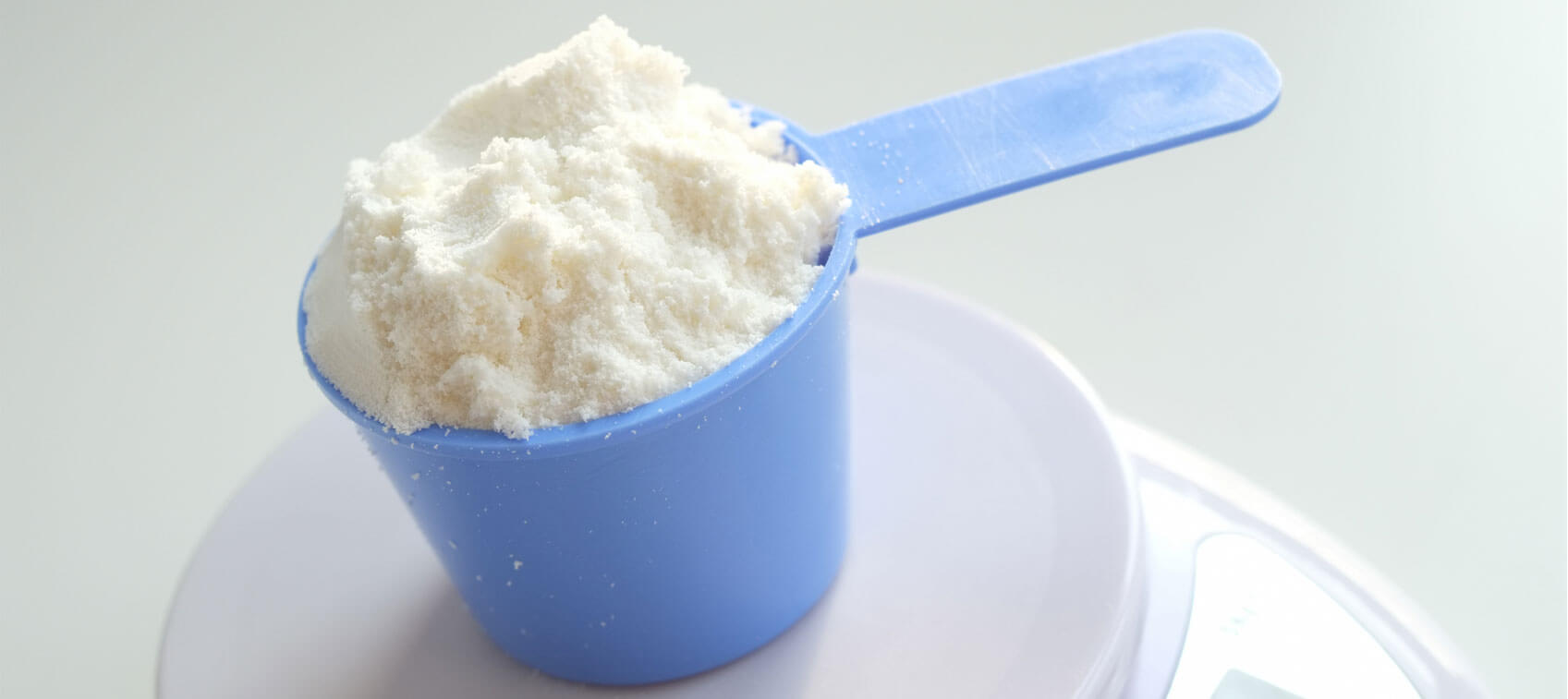
Whey isn’t some glamorous, high-tech product that was just recently discovered. It’s the translucent liquid that separates from the curd when milk coagulates during the cheese-making process. Ages ago it was praised as an elixir, but more recently it has generally been discarded as waste. Some savvy farmers knew it would benefit young farm animals and often utilized it in feed.
In the early 1980s, dairy groups began to explore possible uses for whey other than disposing of it. Researchers developed several methods to remove fats, milk salts, and water from whey. During that same period, there were efforts underway to reduce various fats in the diet—which triggered a considerable amount of research on the possible health benefits of consuming whey powder, which is naturally high in protein.
Before whey powder was available, the most popular sources of protein were lean cuts of meat, fish, legumes, oats, and egg whites. Some early “protein powders” used egg whites, but research found whey to be far superior.
Whey powder could be one of the most potent and cost-effective methods of preserving your health, because this so-called “waste product” is proving to be one of the best supplements to help prevent and treat everything from obesity and diabetes to cancer.
The majority of the benefits of whey can be attributed to its dense content of high-quality protein components. In fact, it has been found to be one of the most complete and biologically active forms of protein available.
Whey is called a complete and balanced protein because it contains all the “essential” amino acids (as well as additional amino acids). Most of the isolated amino acids that are now being touted and sold in the health market are naturally contained in whey protein.
Antimicrobial, Antiviral & Immune Boosting Benefits
Several components of whey—including the immunoglobulins, lactoferrin, lactoferricin, sphingolipids, lactoperoxidase, and glycomacropeptides—can inhibit the growth of a wide range of bacteria, fungi, yeast, and protozoa. In particular, lactoferrin has been shown to stop the growth of two pathogens commonly associated with food poisoning: E. coli and Listeria monocytogenes.
When it comes to immunity, the body’s level of glutathione is a pretty good indicator of overall health and the ability of your immune system to fight off disease and counter the effects of aging.
Whey has a very high content of sulfur-containing amino acids (such as cysteine) that are necessary for the biosynthesis of glutathione. And studies have shown that you can effectively raise your glutathione levels through the consumption of whey protein.
Several components in whey protein work together to improve immunity. A group of blood proteins called immunoglobulins are incorporated into milk and whey. They help pass on immunity to infants and adults as well. Colostrum, the first milk following birth, contains the greatest concentration of these compounds. And the lactoferrin I mentioned earlier actually stimulates the growth of new immune cells. The regular use of whey protein can help keep your body prepared to ward off everything from the flu to cancer.
Anticancer Benefits
To date, most of the studies on whey protein and cancer have been performed using laboratory animals. These studies have found that a diet supplemented with whey protein provides protection against toxin-induced cancers of the esophagus, lung, bladder, colon, liver, and breast. And it appears that the earlier the whey protein is started, the greater the protective effects might be.
Moreover, in one human study whey protein was included with other nutritional factors in the treatment program of 20 patients with stage IV (end-stage) cancer (one patient with bladder cancer, five with breast, two prostate, two non–small cell lung, three colon, one ovarian, one gastric, one neuroblastoma, one mesothelioma, two lymphoma, and one osteocarcoma). After six months of therapy, 16 of the 20 patients were still alive—a much better result than expected without treatment. The survivors maintained higher glutathione levels than the other four.
Two other components of whey protein also contribute to its anti-cancer activity. Sphingomyelin has been shown to help prevent colon cancer and stop the spread and development of various other forms of cancer. CLA, which I’ve highly recommended in the past, has been shown to inhibit a number of types of human cancer cell lines and protect against chemically-induced cancers from environmental toxins.
Cardiovascular Benefits
Whey protein addresses many of the problems associated with cardiovascular disease—and it isn’t associated with any side effects common to heart medications.
Whey proteins inhibit the angiotensin converting enzyme (ACE). I’m sure you’ve heard of the class of blood pressure–lowering drugs called ACE inhibitors that do the same thing. A combination of components in whey powder provides this blood pressure–lowering benefit and vascular relaxation without the side effects of drugs.
Stress Reduction
In a study performed in the Netherlands, researchers gave 29 “stress-vulnerable” subjects the whey protein alpha-lactalbumin. The result was a reduction of cortisol, a hormone commonly associated with unresolved stress. Participants also experienced less depression and an improved ability to cope with their environment. The researchers reported that whey protein increased the availability of tryptophan in the brain, which, in turn, increases the brain’s synthesis of serotonin. The added serotonin promotes a calmer mood and an ability to handle stress.
The glycine content of whey protein also undoubtedly contributes to its ability to help repair tissue and heal wounds. With whey, you also get the added growth factors (IGF-1 and 2)—both of which have been shown to accelerate wound healing in the gut. Finally, glycine is also important in both memory and cognitive functions.
Although you wouldn’t get the high levels of glycine used for panic therapy from a typical whey protein drink, smaller regular doses with the many other components, such as from a daily whey drink, could help you deal with stress and improve sleep. For dosages as high as 3 grams, you would need to purchase a separate supplement.
Whey proteins have also been shown to protect the stomach and intestinal tract from stress-induced ulcers.
Osteoporosis and Bone Cell Growth
In addition to containing minerals necessary for bone growth, whey's lactoferrin is able to increase the production of new bone, which could have enormous impact on the treatment of osteoporosis and non-healing bone fractures. Additional animal research with rabbits found that lactoferrin also protects against bone breakdown.
Prebiotic Benefits of Whey
Prebiotics are foods or compounds that are fermented by bacteria in the colon after they’ve entered the system. You can either supply your colon with additional beneficial bacteria through the use of probiotics, or you can feed the beneficial bacteria already present with specific compounds to help them multiply in number and become more dominant.
When used in combination with a good probiotic, whey protein and its other components act as a prebiotic to provide added assurance that your “second immune system” (your gut) is getting the help it needs. One of the benefits of adding whey to the diet is often the normalization and consistency of bowel movements, particularly in the elderly.
Antioxidant Benefits
The lactoferrin fraction of whey protein binds with iron. The combination provides a stable method of iron transport, and lessens the amount of free iron in the system that can trigger oxidative reactions. (Excess free iron has been a concern in the acceleration of heart disease and other problems.)
In an indirect way, whey protein helps reduce the overall need for antioxidants in your body. Various enzymes, immunoglobulins, and other factors reduce the oxidative burden by reducing inflammation and destroying pathogens (among other activities). In effect, the added protection provided by whey helps your immune system maintain higher “reserves” that can be called upon when necessary. New research has revealed that lowering the oxidative burden in your body may be one of the primary keys to remaining healthy and slowing the aging process.
Obesity, Appetite Suppression & Weight Control
Whey protein is unique in that it can help the overweight lose excess fat and help the underweight gain pounds in the form of lean muscle.
When you drink a whey protein shake in the morning, it’s more than just the initial feeling of fullness that suppresses the urge to eat. Whey protein contains unique chains of 64 amino acids called glycomacropeptides that perform a wide variety of functions—just one of which is to help regulate appetite.
Glycomacropeptides are a very potent stimulator of the release of the hormone cholecystokinin (CCK), which has many functions. First, it stimulates both the pancreas and the gallbladder to improve digestion. Additionally, it regulates emptying of the stomach and movement of your bowels. However, the function of CCK that most research seems to focus on is appetite suppression.
Essentially, glycomacropeptides do naturally what every drug manufacturer in the world is trying to duplicate artificially: increase the release of CCK. The protein signals the brain that the body is full, which suppresses the appetite and results in a large reduction of food intake. It is generally agreed that protein is the most satisfying and quenching macronutrient, but research has shown that not all proteins are alike in this ability. Whey provides a very strong satiety response. One study reported that glycomacropeptides from whey increased the release of CCK by over 400 percent. To find a drug that would safely do the same without side effects would be a pharmaceutical company’s dream.
Dosage of Whey
As a general daily dose, I recommend that most people take about 18 grams of high-quality whey protein a day. The easiest way to get this dose every day is to mix the powder with either skim milk, water, juice, or other liquid, plus a little ice (if desired) in a blender and make a small shake first thing in the morning. You can also experiment by adding various fresh or frozen fruits or vegetables, fruit powders, etc. to the mix.


